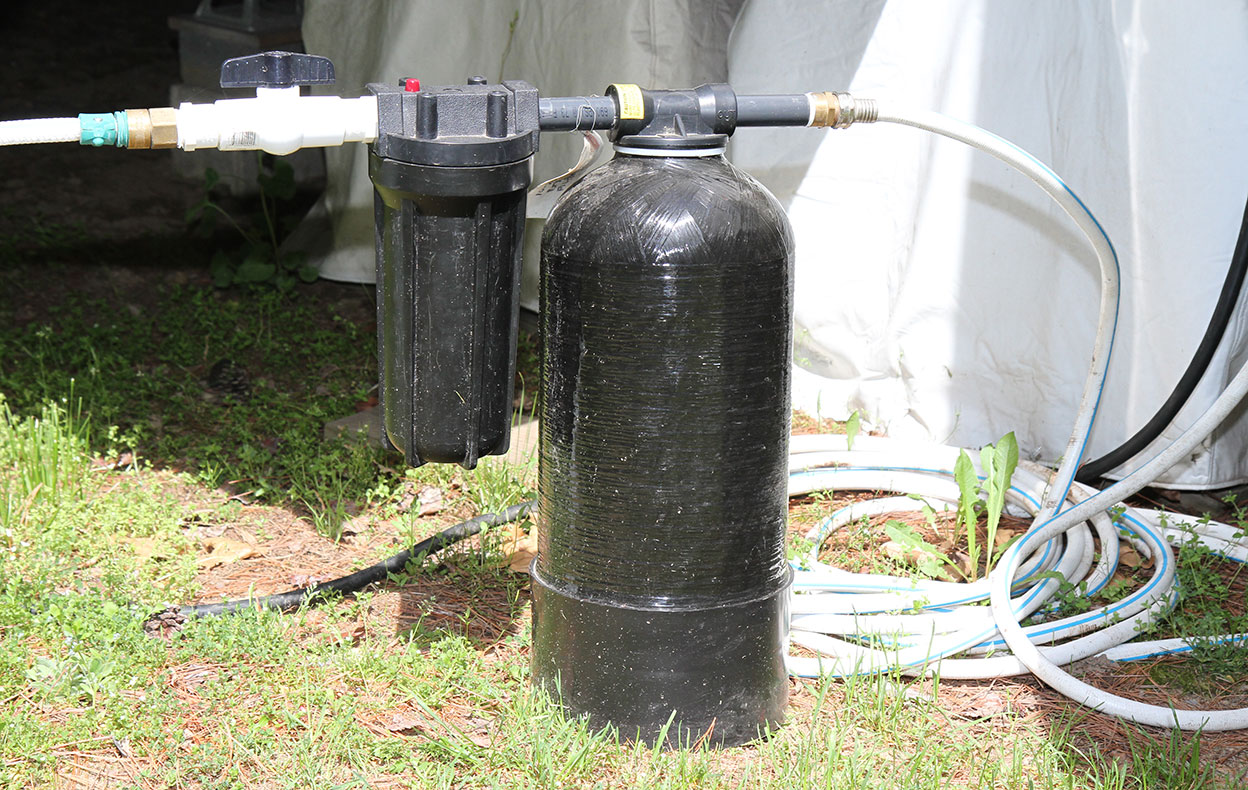Water is a basic necessity in any RV, both for our health as well as convenience for washing dishes, ourselves and other uses. But not all water is created equal. The typical fresh water supply can contain any number of contaminants such as minerals, alkalis and acids or even bacteria and microorganisms such as cysts. All of these items detract from what is desired in clean, pure water. Minerals such as calcium and lime can cause damage to plumbing fixtures. High iron content is equally destructive and bacteria and cysts can leave us with some serious health issues.
Fortunately, there are a number of ways that water can be treated or conditioned to rectify these situations. But each type of system has its own area where it functions well and other areas where it does not so you need to determine which particular water condition you need to treat. You wouldn’t go to an orthopedic surgeon for an issue with your heart nor would you go to a cardiac doctor for a hip replacement. In the same way choosing the correct solution for your specific water supply condition is just as important.
ORP and pH
One particular acronym that is well known in the health care field but not so much in the RV industry is ORP, which stands for Oxidation Reduction Potential and is also known as Redox. ORP is a measure of the tendency of water to either acquire or donate electrons. Oxidative agents (like free radicals) need and acquire electrons. Reductive agents, (antioxidants) donate electrons. ORP is measured in millivolts (mv). An ORP of 400 mv is four times more anti-oxidizing than an ORP of 100 mv. We’ll see later on when we talk about reverse osmosis systems why ORP is important.
ORP is not pH, which is the measurement of the acidity or alkalinity of a solution. pH stands for “potential hydrogen” and measures on a scale of 0 to 14, with 7 being neutral. pH less than 7 is acidic so the lower the number, the greater the acidity is with a pH of zero being extremely acidic. A pH measurement greater than 7 is alkaline, with a pH of 14 being the most extreme alkaline. Blood typically has a pH of between 7.35 and 7.45, which means it is slightly alkaline. Your stomach is acidic so that it can break down and digest your food. Your body fights hard to neutralize acids and maintain the proper pH in organs, tissues and body fluids. But it can only do that for so long before a condition known as acidosis occurs. You have to give the body what it needs, in the form of alkalizing fruits and vegetables, so that it can properly maintain the delicate acid base balance. However there is a loose relationship between pH and ORP. High pH (alkaline) water has more reducing agents (-ORP) and low pH water (+ORP) has more oxidizing agents. A negative ORP is only beneficial to the body if the pH occurs naturally in the water due to its minerals.
Oxidation is great because it kills bacteria in swimming pools and sewage systems but isn’t something that does any good in the human body. Oxidation is what forms rust, which weakens metal. It also turns an apple brown once it’s been cut and occurs by stealing electrons from whatever is being oxidized. A reducing agent, or antioxidant, is something that inhibits or slows the process of oxidation. Instead of stealing electrons from the surface it donates them.
Most types of water, including tap water and bottled water are oxidizing agents because their ORP is a positive value, generally between +200 to +600 mv. Alkaline ionized water is an anti-oxidizing agent, as it has a negative ORP value and is able to donate extra electrons to neutralize the harmful effects of free radicals in the body. This shows that health wise, it makes sense that the optimal drinking water should have a negative ORP. Many water sources have chlorine in them to kill harmful bacteria, which gives them a positive ORP. But the fluids in the human body will still have a negative ORP because the drinking water with a high ORP is reduced to a negative ORP at the expense of consuming the electrical energy from cell membranes.
Oxidation is a regular function of cell metabolism and strips an electron from free radical molecules. These molecules then strip an electron from another cell to repair themselves and the cycle continues but finally ends when it finds a donor molecule with a free electron to give. These donor molecules are called antioxidants and can be provided by nature in vitamin C and E, Beta Carotene, Selenium, etc. Oxidation is the leading cause for premature aging and degenerative diseases. Pollution, chemicals, food additives and antibiotics dramatically accelerate the oxidation process. Refined foods have much of the vitamins and antioxidants removed during processing so unless you are eating farm-to-table you’ll need to take supplements. People who take regular doses of supplements such as vitamin C &E, Beta Carotene, grape seed extract and alpha lipoic acid have lower rates of heart disease, cancer and chronic degenerative diseases. Like these supplements, ionized water is a natural antioxidant and is easily absorbed into your system because it’s already dissolved.
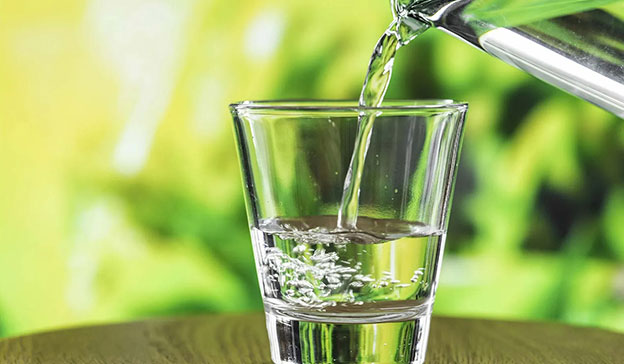
Hydration
Of course, even the most perfect water won’t help unless you drink it. 75% of North Americans are chronically dehydrated. Symptoms vary as per the following table:
| Dehydration | Symptoms | |
|---|---|---|
| 1% | Increased body temperature | |
| 2-4% | Typical loss during intense physical activity | |
| 3% | Impaired performance | |
| 5% | Heat cramps, chills, nausea, clammy skin, rapid pulse, 20-30% decrease in endurance capacity | |
| 6-10% | Gastrointestinal problems, heat exhaustion, dizziness, headache, dry mouth and fatigue | |
| 8% | Severe, potentially fatal level, may lose loss of thirst | |
| 10% | Heat stroke, hallucinations, lack of sweat and urine, high body temperature and an unsteady walk |
A recent study at the University of Washington found that drinking 5 glasses of water a day decreases the risk of breast cancer by 79%, bladder cancer 50% and colon cancer by 35%. When cells are dehydrated the membrane becomes convoluted and oxygen and nutrients find it harder to penetrate the cell’s membrane nor can waste products exit the cell. It’s especially important for smokers and people who eat instant food to drink a greater volume of water to preserve their health. One common problem is that our thirst signals decline as we become more accustomed to dehydration and as we age so we don’t drink as much water as we should.
A simple method for determining how much water you should consume in a day is to take your body weight in pounds and divide it by two. That is the number of ounces of water that you should drink in one day. Don’t count on coffee or soda pop to supplement your water intake. The caffeine found in coffee and soda means you will have to drink an equal amount of water just to break even and cancel the negative effects brought by the coffee or soda. The sugar content in soda exerts osmotic pressure and water is lost from the blood to make the soda dilute enough to leave the stomach. Sports drinks are good for extreme athletes who burn through blood sugar and electrolytes during extended workouts but the average guy who works out at the gym will get enough nutrients from their food to make up for what is lost during athletics.
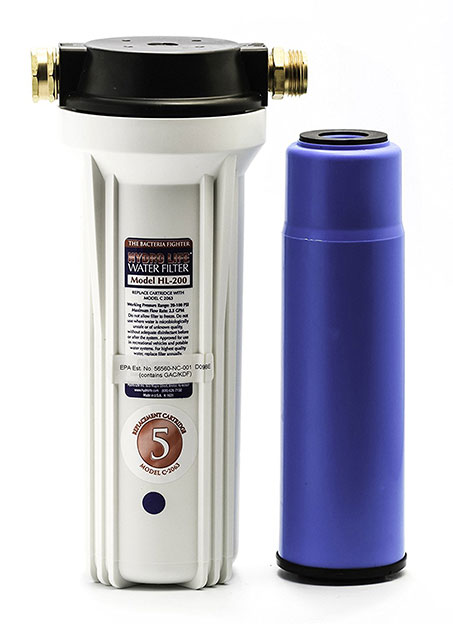
Filters
Filters are fairly simple in theory. They are just like a screen that keeps large particles out. The finer the screen, the more particles will be removed. Filters are commonly rated in microns. One micron is equal to one millionth of a meter therefore a filter that is rated at 10 microns will filter finer particles than one rated at 40 microns. A filter with a low numerical rating also creates more restriction to a similar sized filter with a higher rating because the finer filter media creates more resistance to water flow. But choosing a larger filter with more surface area can overcome this and restore the water flow to an acceptable level. Most motorhomes will come equipped with a whole house canister style filter with replaceable elements to filter all of your coach’s water.
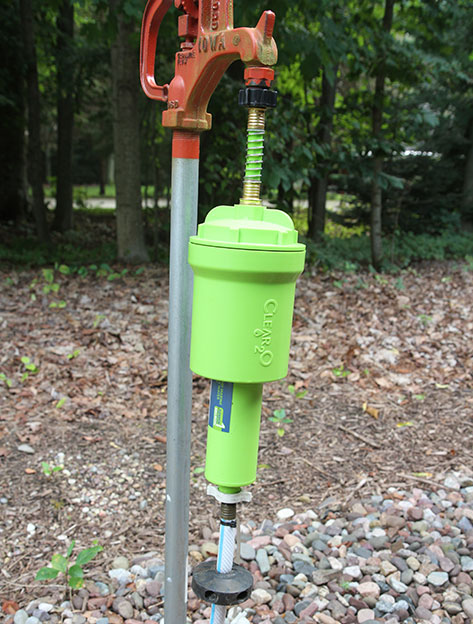
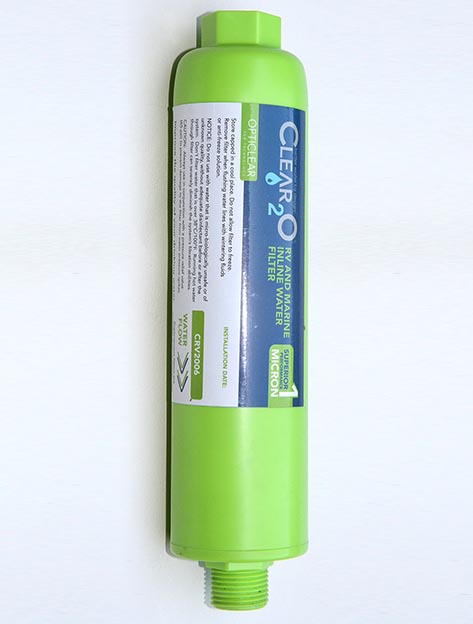
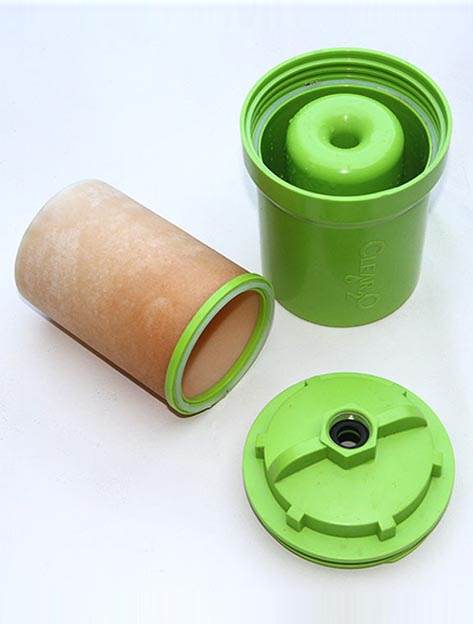
Filter media varies from one filter to another. A common basic filter uses pleated paper to filter out particles, much like the air filter in your vehicle. Once the paper pleats fill up with particles that have been removed from the water the filter will restrict flow and need to be replaced. Other filters may use a blow molded media that allows the particles to be embedded into the filter with some depth, which will result in longer life. Both of these types are basic filters suitable for removing sand and solid particles from the water as long as they are larger in size than the micron rating on the filter. They will not remove fine particles or ions that are suspended in the water so while they filter the water, they do not treat it.
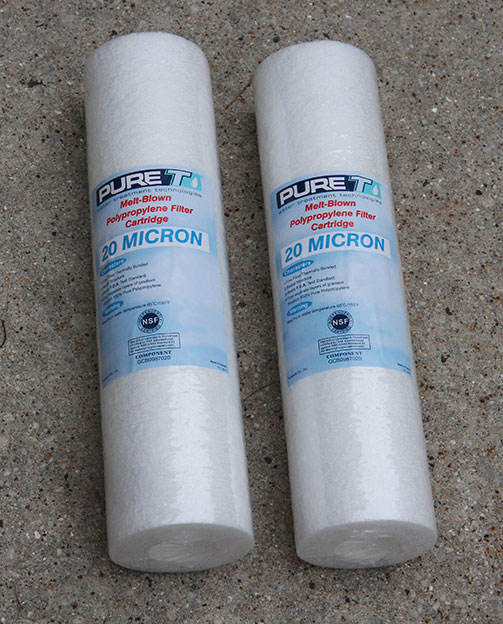
Carbon is an excellent choice for removing odors in the air. It also works well to treat water, removing taste and odor artifacts from your water supply. Carbon filters will remove chlorine, sulphur and other contaminants from your water supply. There is some discussion regarding removing chlorine from fresh water tanks but in reality it’s not a concern. If the water in the tank is used and replenished on a regular basis, such as when full-timing, the water will never get stagnant. If the water in the fresh tank does sit around and get stagnant, especially in hot climates, the chlorine will evaporate out of the tank anyway. Your best bet is to sanitize the fresh tank when needed. If used regularly this may only need to be an annual thing but if allowed to sit for extended periods of time you may need to do this much more frequently.
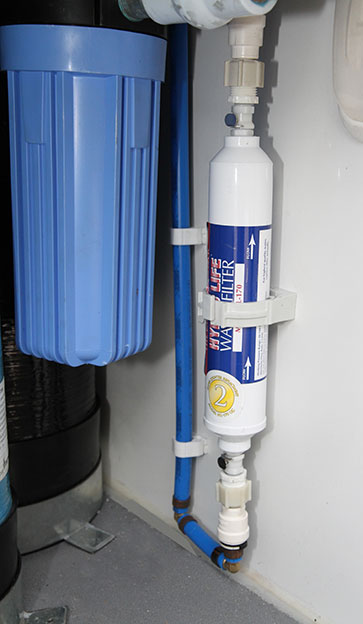
One drawback to carbon is that bacteria can build up and grow inside the filter. By choosing a bacteriostatic filter with Kinetic Degradation Fluxion (KDF) media you will prevent this. The KDF media is a high purity copper-zinc media interspersed with the granular activated carbon (GAC) media inside the filter. It protects the carbon media by extending its life and preventing fouling due to bacteria growth through a process called redox (oxidation/reduction). It will remove chlorine, lead, mercury hydrogen sulfide and even iron to an extent from the water supply. The GAC/KDF filters cost a bit more than standard GAC filters but the results are well worth it.
Another filtration system is the Quantum Disinfection system by US Water Systems. This technology uses highly charged substrate areas that have been modified via a patented process. Any microorganism, (bacteria, yeast, virus or cyst) is immediately destroyed as it comes in contact with the media. UV systems kill the bacteria with UV light but the dead bacteria remain in the water. Quantum disinfection actually removes the dead bacteria from the water. The drawback to Quantum disinfection is that algae iron, and suspended solids can bind the media so you need to pre-filter the water prior to entering the Quantum filter. But the end result is that 99.99% of all bacteria are removed. Any water entering this system must first be filtered by a prefilter to remove iron, sulfur and other elements that can render the Quantum Disinfection media inoperative.
Iron Filters
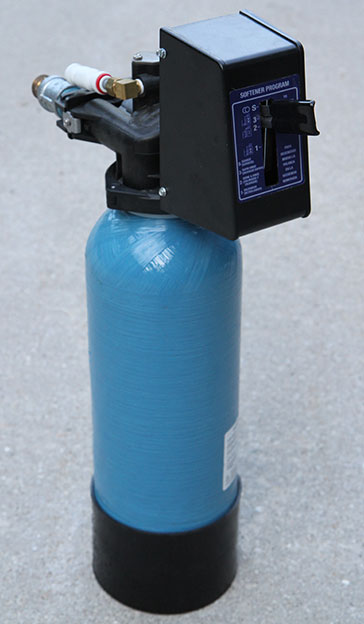
Water with a high iron content will affect the taste of the water as well as leave ugly stains in your plumbing fixtures. Iron can be difficult to remove from the water supply. To a certain extent KDF based filters can remove the iron or at least reduce it to an acceptable level if the iron content is fairly low. But for those water supplies that have a fairly high iron content a dedicated iron filter, which will also remove sulphur, will be required. Iron filters operate by drawing air into an oxidation chamber where the iron or sulphur is oxidized into particulate. The water then percolates over a bed of filtration media that traps the iron or sulphur oxides before exiting the filter. When the media no longer is effective, the iron filter is regenerated by backflushing, similar to a water softener. However, no salt or brine tank is required. The filter is simply backflushed with water and then air is allowed to enter the top of the filter to recharge it. Iron filters can be equipped with manual heads or automatic heads to facilitate regeneration. A drain line is required to be connected to the gray water tank or sewer to accommodate the waste water when backflushing although the water is safe and could be dispersed onto the ground if allowed. The media has a long life and most likely you’ll never have to replace the filter or its media for as long as you own the coach. Because it does not require disposable filters or salt for its operation it’s basically a zero cost maintenance item for as long as you own the filter.
Water Softeners
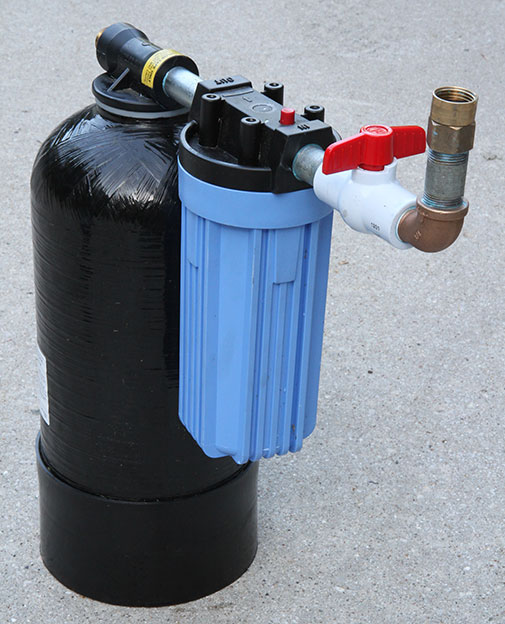
Perhaps the most common situation is hard water, which is water that is high in mineral content. Hard water isn’t all that harmful to your health. In fact the World Health Organization has found that hard water can be a good dietary supplement, rich in calcium and zinc, as long as it isn’t too excessive which makes it’s taste undesirable. But hard water isn’t the greatest for your coach’s fresh water system. Minerals such as calcium carbonate will cause a lime scale buildup. This scale can restrict flow in Pex water lines and can also lead to galvanic corrosion when two dissimilar metals are in contact with each other. Hard water also inhibits soap suds, leaving a soap scum after showering or leaving white calcium deposits plastered to the side of dishes and cups after dishwashing.
Hard water can’t be effectively treated by conventional filters and will require a water softener to effectively treat hard water. A water softener consists of a tank filled with polymer resin beads and operates on an ion exchange principle. The resin is treated with a salt brine that is given a salt bath that coats the media with sodium ions. As the water passes through the softener the resin exchanges the calcium and magnesium ions for sodium ions, which effectively neutralizes the hardness in the water. Eventually the sodium ions become depleted and the resin beads become coated with the calcium and magnesium ions. At this point the softener won’t be able to treat any more hard water and will require regeneration.
Regeneration is a process where the ion exchange process is reversed. A salt brine is passed through the softener and picks up the hard water deposits from the resin media and carries it out into the waste water through a backwash process. Once these deposits have been removed from the resin a salt brine is run through the softener to recoat the resin with sodium ions so that it can continue to soften future incoming water. Residential softeners are equipped with metering systems and automatic regeneration controls to do this automatically, based on the volume of water but these are designed for a residential application and are too large for use in a motorhome. Small portable units are available for RV applications but these will require manual regeneration. Inexpensive test strips will allow the RV owner to sample their water and measure the hardness according to a color chart to determine when regeneration is necessary.
I originally had one of these manually regenerated units in our coaches. This was a good unit that was equipped with a canister-style pre-filter housing that contained a blow-molded element to prolong the life of the softener’s media. When the softener needed regeneration I would have to shut off the water to the coach, remove the prefilter from the canister and fill the canister with solar salt crystal and insert a pickup tube to draw water from the bottom of the housing. Then the water was turned back on and a sink faucet was opened so that the water flow was about the size of a pencil stream. The water would run for about 30 minutes as the salt in the prefilter housing ran through the softener and regenerated the sodium ions in the media. I then shut off the water, dumped out the little bit of salt that remained in the canister, removed the pick-up tube and installed a new blow-molded prefilter element. I then turned the water back on and drained the gray tank, which now had all of the backwash water in it. All told we were without water for about 45 minutes during this process.
Fortunately, National Indoor RV Centers handles a custom residential system by Motor Coach Water Filtration that is compact enough to fit in a basement compartment of a class A coach. I replaced my original manual softener with one of these in our Entegra Cornerstone and it’s a world of difference from my previous manually regenerated unit. This softener has a meter that monitors water consumption and can automatically regenerate the softener at a set time after a specified number of gallons have passed threough the softener. Typically I set my softener to 600 gallons of water and have it programmed to perform this at 2 AM in the morning when we are sleeping. The regeneration process takes over an hour but at 2 AM, that’s not a concern.
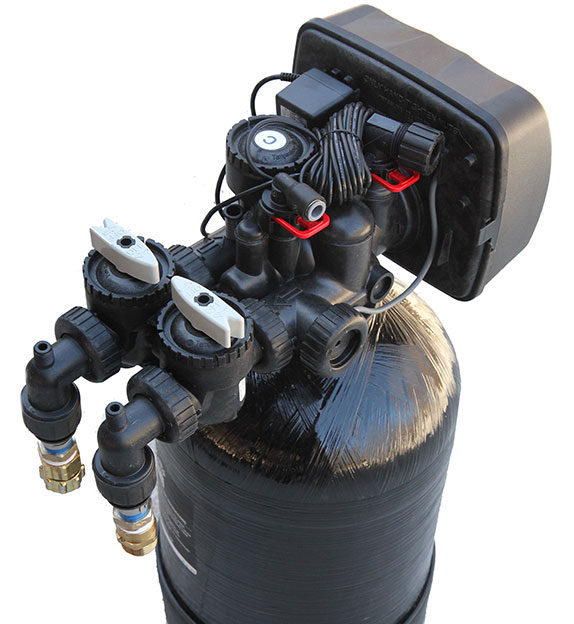
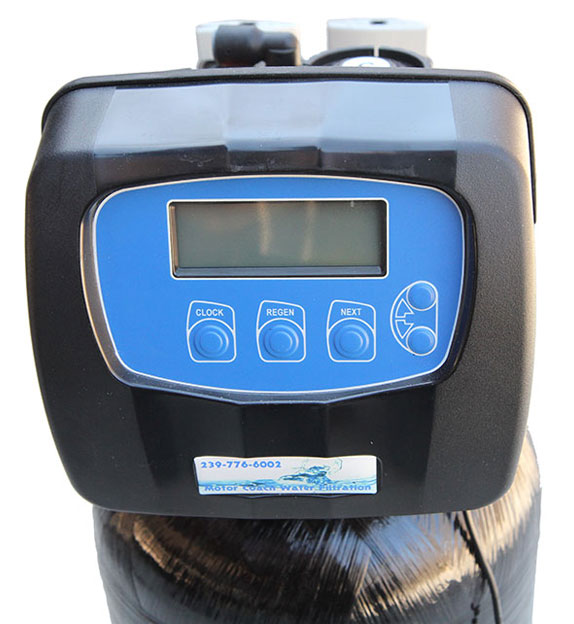
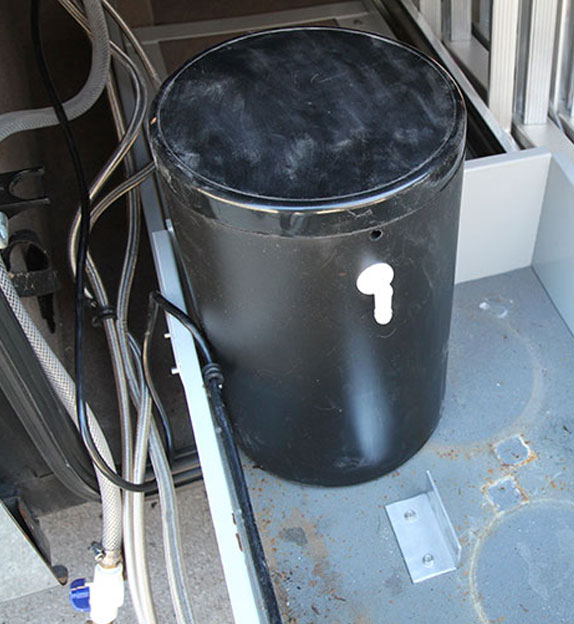
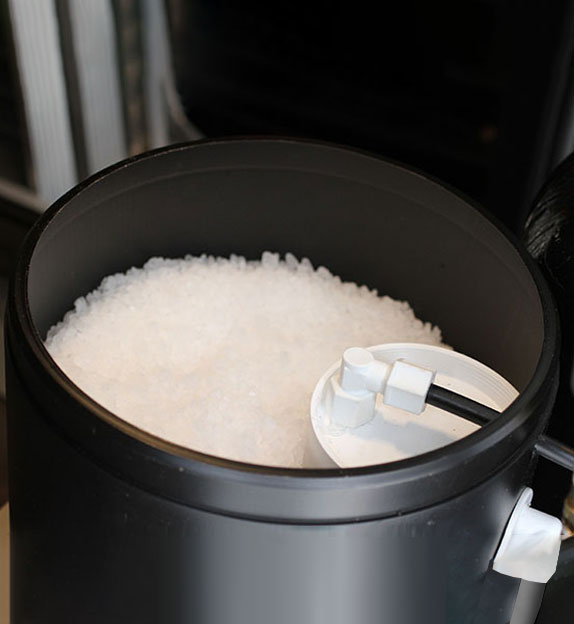
The regeneration process backwashes the softener’s media, then draws the salt brine in from the brine tank to regenerate the media. After a period of time it refills the brine tank with fresh water so that the brine will be ready for the next time regeneration is needed. The whole process is fully automated, uses less water than the manually regenerated systems and never locks out your water usage during this process because the softener goes into bypass mode during regeneration. The only user intervention is to dump some salt into the brine tank every month or so and make sure your gray tank isn’t very full on the day the system will regenerate. The gallons remaining will be displayed on the softener’s LCD display and you can manually regenerate at any time or set it to regenerate at 2 AM that evening if the water at this particular stop is particularly hard.
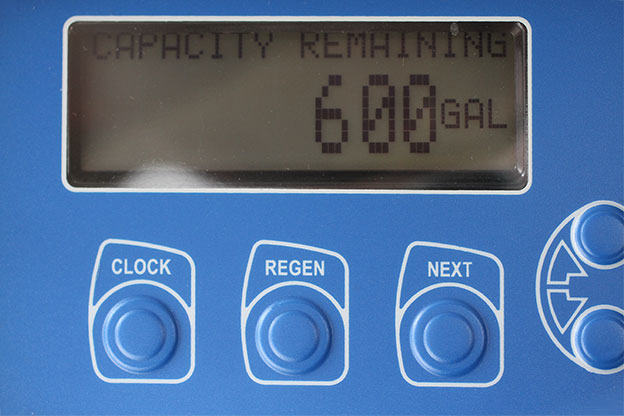
When selecting a water softener, keep in mind that some water softener claims can be suspect. Any softener advertising that claims to treat a certain amount of gallons is misleading. Water softeners are capable of treating a given amount of hardness in the water. If the water is mildly hard it will treat many more gallons than when treating water that is extremely hard. Some areas such as the Pacific Northwest and New England states have the softest water while the Great Lakes states have moderately hard water. Arizona, New Mexico, Texas and the southern portion of California are known for extremely hard water. Softeners with larger tank sizes will be able to treat more water between regeneration cycles than softeners with smaller tanks. The trade-off for a motorhome owner is that storage space is limited so compromises do have to be made. If space is not available you can always utilize a large softener and place it outside the coach near the campground water supply, which works quite well in a full-time environment where you have an extended stay at that campground. However the softener must be kept from freezing so if the weather drops below freezing during the night you could damage the softener. Also, softeners should be transported in the vertical position because the strainer basket can be damaged in transported in the horizontal position.
Deionized Water
It stands to reason that if ionized water is good for your health then deionized water is bad for your health because certain minerals are needed in our daily intake. Deionized water is simply water that has had all of the ionized particles removed. Once all of the organic material has been filtered from the water supply, all that’s left are ions such as calcium, sodium, chlorides, etc. When you wash and rinse your coach the water will evaporate but the minerals in the water remain and leave water spots behind on your painted finish. The way to eliminate this is to deionize your rinse water, which replaces the positively charged mineral ions such as calcium, magnesium, iron and sodium (cations) and negatively charged ions such as silica, chlorides, sulfates, nitrates and carbonates (anions) with hydrogen (H+) and Hydroxyl (OH-) ions, which combine to make pure water that will not leave any water spots when dry.
Deionizers can be had in a variety of configurations. Like a water softener, the media will eventually give up its ions and no longer work. It either needs to be replaced or regenerated. Regeneration is only feasible on large scale applications because concentrated acid and caustic material is used to strip away accumulated ions through physical replacement. For normal consumer use, such as in our RV wash routines, replacement cartridges are more desirable. A two bed system uses separate cation and anion resin beds. Both types of resin are required to totally deionize water but mixed bed systems are available that only require one tank. A mixed bed system provides the highest water quality while a two bed system has a larger capacity. Once the resin has been exhausted it must be replaced. Some tanks can be rebed with new bulk media while some systems use disposable cartridges. A dual probe TDS (Total Dissolved Solids) meter, with one probe sampling incoming water and the other sampling the outgoing deionized water, can tell you when your media is no longer functioning. Deionizer media life can be extended by using regular softened water for washing the coach, reserving the deionized water for the final rinse.
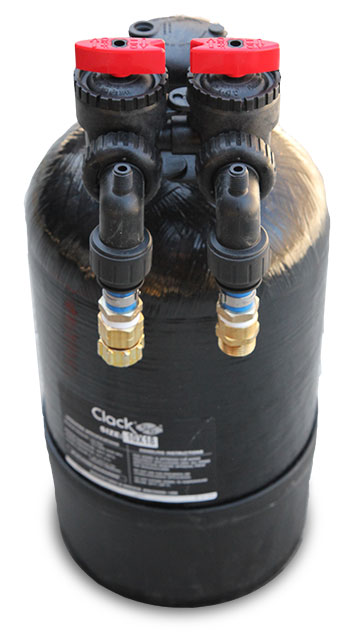
On my coach I use a large mixed bed system from Motor Coach Water Filtration that NIRVC handles. It has a longer life than the two smaller portable tank system that I previously used. I strictly use this for my rinse water and that lasts me between 1-2 years, depending on how often I use it. I installed a TDS meter to measure the incoming and outgoing water quality so that I know when to rebed the softener, which is simply done by dumping the old media out and replacing it with new media. The end result is that I no longer have any water spots so I don’t have to quickly wipe down the coach after rinsing.
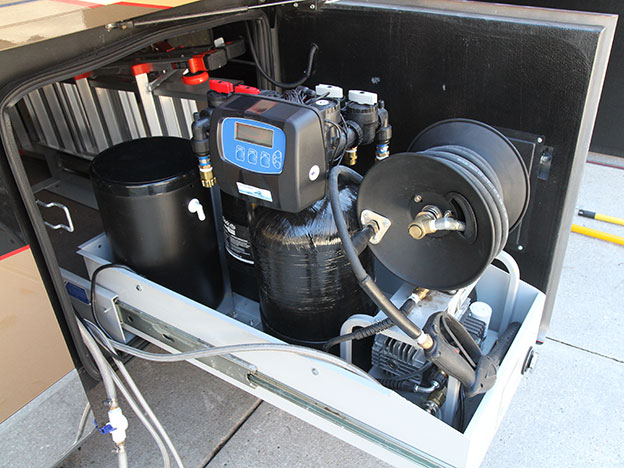
Reverse Osmosis Systems
One popular trend with RV owners is the increased use of reverse osmosis (RO) systems. The RO water purification method involves forcing water through a permeable membrane, which filters out any contaminants, depending on their size. If the contaminants are larger in size than the water molecules they will be filtered out but if they are smaller in size they will remain in the water as it passes through the membrane. RO systems do require pressure to force the water through the membrane. There is a fair amount of waste water involved in the RO process and the fairly low water pressure found in an RV water system means you’ll waste more water than you purify. The filtered water passes through the RO system quite slowly so it is put into a storage tank so that it can be used as needed. RO systems require reasonably clean water to begin with and will utilize pre-filters and carbon block filters prior to entering the RO membrane. The water that passes through the membrane will be 95-99% pure. In fact it can be too pure.
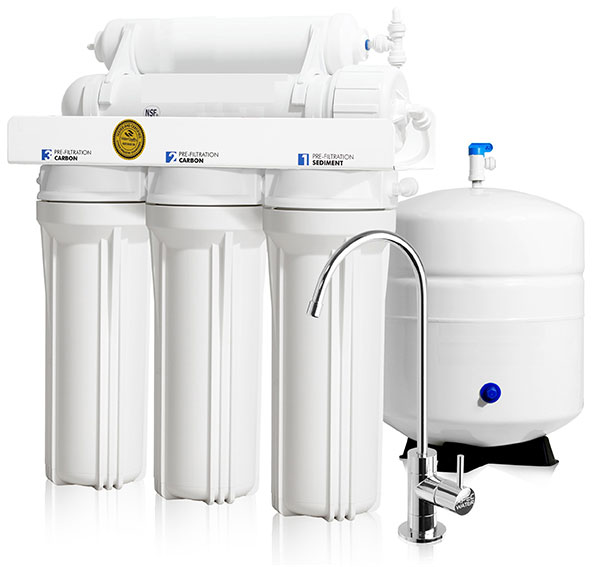
The main health benefit to RO water is that the RO system removes unhealthy contaminants such as arsenic, nitrates, sodium, copper, lead, some organic chemicals and the municipal additive fluoride. However, the disadvantages of RO water can outweigh its benefits. RO water is demineralized yet minerals are an important component to our health. The World Health Organization released a report in 2009 stating that RO water has a definite adverse influence on our health. Some nations began using RO water treatment in their municipal systems and in just a few short months the effects began to show. Increased cardiovascular disorders, gastrointestinal problems, tired, weakness and muscle cramps were common. Not only does RO water not contain the minerals our bodies need but it also leaches minerals from our bodies. Most notable, calcium was leached out of bones, resulting in bone density issues and joint conditions. Any minerals that are consumed in the food we eat are simply being urinated away. Studies have shown that increased mineral intake from food was not sufficient to compensate for the mineral loss from RO water. The end result was effective dehydration with the same accompanying symptoms.
RO water is also acidic. As we saw earlier in the section on ORP, our bodies need to retain a proper alkaline balance and adding acidic water will harm that. RO water is corrosive to our fresh water system plumbing. Brass fittings, faucet fixtures and water pump components can have shorter lives. Also, RO systems do not totally remove everything. Volatile organic chemicals (VOCs), chlorine, pharmaceuticals and a number of other synthetic chemicals are not filtered from an RO system. If you have an RO water system and aren’t ready to give it up you can add a remineralization cartridge to your RO system’s output to put back some of what has been removed. This isn’t as good as drinking water that contains minerals naturally but it will help somewhat with the acid-alkaline balance in the body.
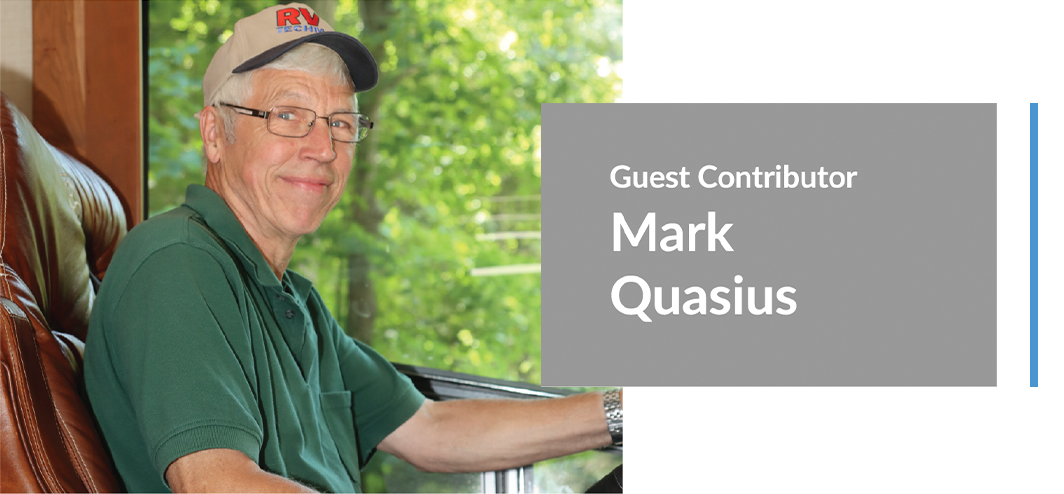
Mark Quasius is the founder of RVtechMag.com, the past Midwest editor of RV Magazine, writes for numerous RV-related publications and a regular Contributor to FMCA’s Family RVing Magazine. Mark and his wife Leann travel in their 2016 Entegra Cornerstone.

